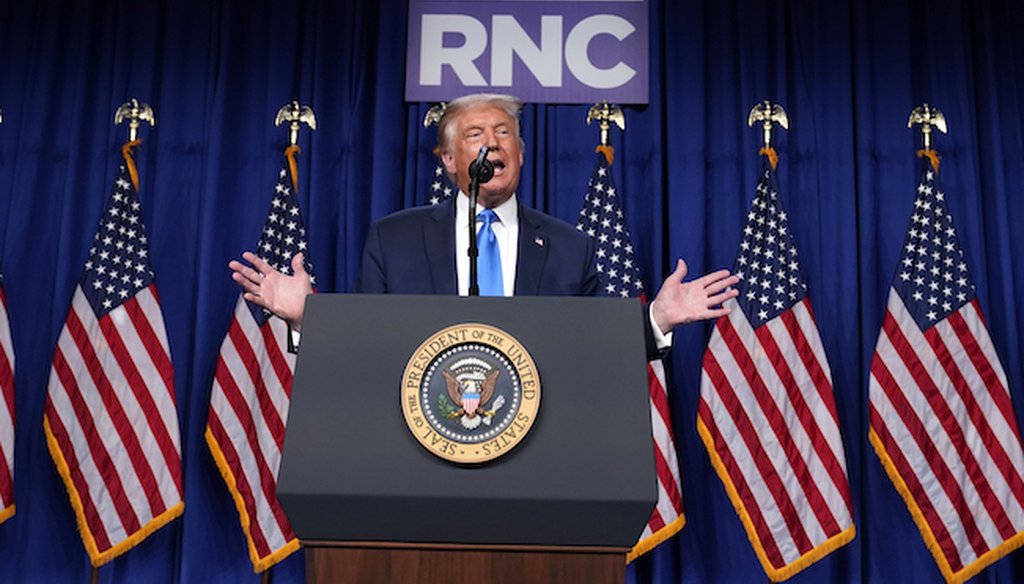Get PolitiFact in your inbox.

President Donald Trump speaks on stage during the first day of the Republican National Committee convention, Monday, Aug. 24, 2020, in Charlotte. (AP Photo/Evan Vucci)
If Your Time is short
- We examined several claims from Trump's hour-long speech in Charlotte at the 2020 Republican National Convention.
- We previously fact-checked Joe Biden's acceptance speech at the Democratic National Convention.
President Donald Trump addressed delegates to the 2020 Republican National Convention for more than an hour Monday in Charlotte, N.C., veering from the political norms (the nominee doesn't typically speak extensively until the final night), and often, the facts.
Trump spoke to delegates after he was officially renominated by the Republican Party as its candidate for president, contrasting the soaring economy he says he built in his first three years of office with Democrats — who "want no God. No God. It’s no religion, no guns, no oil and gas."
The president made several claims that were either wrong, misleading, premature or needed clarification.
About mail-in voting, "they’re going to go knock on everybody’s door. Here, would you sign this? Yeah, I’ll sign it. Nobody knows who the hell is signing it. And they now want to have it where the signature doesn’t have to be verified. That’s right. The signature doesn’t have to be verified."
Mail-in ballots are verified. Trump is wrong.
Whether voters live in a state that automatically sends ballots or if they live in a state where voters can request ballots, there are steps election officials use to verify ballots.
"The majority of states are comparing the signature against one on file, either taken during registration or at some other transaction with the DMV or elections office," said Matthew Weil, an elections expert at the Bipartisan Policy Center. "Other states require witness signatures, notarized signatures, a photocopy of ID, or they verify that the ballot envelope is signed. Importantly, a state knows which voters have requested the absentee ballot and to whom an absentee ballot is sent. They track which ballot styles voters are given and there would be immediate red flags if a voter returned a ballot they had no right to cast."
Not every state verifies signatures specifically, but they all do some form of verification, said Rick Hasen, a University of California-Irvine law professor who specializes in election law.
The verification process begins before any ballot is sent out. It starts with voter registration, a process that requires officials to determine if someone is eligible. Election offices also periodically update their registration lists, including removing inactive voters or those who have died. Many states are members of the Electronic Registration Information Center, which sends each member state reports showing voters who have moved within their state or out of state, have died or duplicate registrations.
"I took over a country whose military was depleted and whose cupboard on this front (COVID-19) were bare. The cupboards were bare. We didn’t have anything. We didn’t have a thing."
This is an extreme exaggeration. Military spending was down during Obama’s tenure, and the Trump administration has made some strides in improving the military’s operational readiness. But the military was not "depleted. Military experts previously told us that most weapons and infrastructure are close to the same as they were before he took office.
On health care, Trump has repeatedly claimed that Obama left him with an empty national stockpile of emergency supplies. But this, too, is an exaggeration.
The stockpile had a shortage of N95 masks, which were depleted as a result of the H1N1 outbreak in 2009 and not substantially replenished during the Obama or Trump administrations.
ProPublica found that the budget battles during Obama’s tenure after the Republicans won the 2010 election also hurt the stockpile’s budget.
Budget figures going back to 2009 show overall funding for the stockpile dropped to its lowest in 2013, to about $477 million. Allocations have grown steadily since then to a 2020 budget of $705 million.
"We've built our wall, which will be finished very shortly."
This is not true. Trump's administration has mainly replaced barriers installed by previous administrations with new ones that are expected to be more effective in stopping illegal immigration and drug smuggling. The dollars for construction comes from U.S. taxpayers, particularly the U.S. departments of Homeland Security and Defense, and from the Treasury Forfeiture Fund. He did not get Mexico to pay for any construction as he promised in 2016.
Before Trump became president, the southwest border had 654 miles of primary barriers. As of late June, that was up by three miles, to 657. Around 200 miles of older primary barriers have been replaced with updated fences. The new fences pose "a formidable barrier, but it is not the high, thick masonry structure that most dictionaries term a 'wall'," said a January report from the Congressional Research Service. We’ve rated Trump’s promise to build a border wall and make Mexico pay for it as Promise Broken.
"They are trying to steal the election from the Republicans, that’s what it means … just like they did it last time with spying and we caught them, and that included President Obama and that included, let’s be nice, Biden."
This is False. Multiple independent investigations, including a series of bipartisan Senate reports, found no influence by the Obama administration over the FBI investigation of Russian interference in the 2016 election and contacts with the Trump campaign.
The FBI targeted four people with greater or lesser roles in the Trump campaign, but conducted that independently of the White House, a review by the Justice Department found.
"We've achieved American energy independence."
It hasn’t happened yet, but the country is moving toward it.
One definition of energy independence says it occurs when domestic production outpaces domestic consumption. For the U.S., the gap between production and consumption has been narrowing for some time, and the two figures have been running neck and neck.
Some experts prefer another sense of the phrase, which defines energy independence as total disengagement from the global energy market, or zero imports. By that definition, the U.S. is much farther from achieving energy independence because the country still imports a significant amount of petroleum.
The U.S. is close to regularly producing more energy than it consumes and exporting more energy than it imports. But it hasn't settled into complete energy independence in that way yet. We’ve rated Trump’s promise to achieve energy independence a Compromise.
"I can promise you a few things. Number one, we will not be taking the word, God, out of the Pledge of Allegiance, okay, like they did a number of times at their caucuses. So they took the word God out. I heard it. I was listening and I said, ‘That’s strange.’ It’s sort of weird. You’ve heard it all your life, right? Under God, under God. All of a sudden, those two words are missing. I said, ‘Oh, he must’ve made a mistake.’"
This needs more context. On each night of the DNC, "under God" was included in the Pledge of Allegiance.
Some Democratic caucuses omitted "one nation under God" from the Pledge of Allegiance during DNC meetings, but the line was not excluded from the primetime televised spots.
"We eliminated Obamacare's horrible and very unfair individual mandate, which basically knocked out Obamacare. We knocked out Obamacare."
Saying Republicans "knocked out Obamacare" is a stretch. Trump did sign legislation to eliminate the requirement that Americans have health insurance or pay a tax penalty, but eliminating this requirement did not get rid of Obamacare, or the Affordable Care Act, as it is officially known.
The administration supports a lawsuit by a group of Republican state attorneys general that argues that the ACA should be ruled unconstitutional. The lawsuit’s argument focuses on the Supreme Court’s previous ruling that the ACA was constitutional because it was based on a tax, which is a legitimate congressional power. The lawsuit argues that with the tax penalty now eliminated, the law should be scrapped entirely. The Supreme Court has agreed to hear the case.
In the meantime, much of the law’s key provisions remain in force. In 2020, at least 11.4 million Americans have purchased insurance through the online marketplaces created under the act. More than 10 million others have signed up for Medicaid under the expanded eligibility requirements passed as part of the law. And people who have private insurance have benefited from new rules enacted by the law, from the ability to keep young adults on a parent’s policy to an end to out-of-pocket payments for certain preventive measures.
"So we protected your preexisting conditions, very strongly protected."
We rated a similar claim Pants on Fire. Protections for preexisting conditions under Obamacare remain on the books, but it’s not for lack of trying by the Trump administration.
For starters, the administration backs the lawsuit that would eliminate protections for preexisting conditions by getting rid of Obamacare.
In addition, the administration has not put forth any plan that might keep those guarantees in place. Every replacement health bill the administration has endorsed has offered protections less generous than those offered by the ACA.
Finally, the administration has issued a rule loosening restrictions on the length of so-called short-term health plans. While such plans could be more affordable for individuals in the market for insurance, they are not required to provide preexisting condition protections.
"We’re putting a lot of manufacturing jobs to work that the previous administration said you’d need a magic wand."
This needs context. Manufacturing employment did increase from mid 2017 to early 2019, but at roughly the same pace as it did for most of President Barack Obama's tenure. For the year between early 2019 and early 2020, manufacturing employment stagnated. Then the coronavirus hit and manufacturing jobs, like jobs in many other sectors, fell dramatically.
"We passed the biggest tax cuts … in the history of our country."
That’s wrong. The Joint Committee on Taxation — Congress’s nonpartisan arbiter of tax analysis — said the 2017 tax bill would cost the government (or save taxpayers) about $1.5 trillion over 10 years, or about $150 billion a year.
Several bills since 1980 were larger, according to the Treasury Department, measured not only by contemporary dollars but also by inflation-adjusted dollars and as a percentage of gross domestic product, which is a measure of the size of the overall economy. In inflation-adjusted dollars, the recent tax bill is the fourth-largest since 1940. And as a percentage of GDP, it ranks seventh. We’ve summarized the tax laws here.
"We fixed a horrible deal that was made with South Korea. Remember, that was a Hillary Clinton special. She said, ‘This will produce 250,000 jobs.’ And she was right. Except unfortunately, the jobs went to South Korea, not to us."
Clinton didn’t say that. Barack Obama said something slightly closer, but Trump’s recollection is still off-base.
In his 2011 State of the Union address, Obama said, "Recently, we signed agreements with India and China that will support more than 250,000 jobs here in the United States. And last month, we finalized a trade agreement with South Korea that will support at least 70,000 American jobs."
So Obama was speaking about 70,000 jobs being created from the South Korea trade deal; the 250,000 figure referred to deals with India and China.
Trade skeptics have blamed such agreements from hurting employment in the United States. In 2015, the liberal Economic Policy Institute estimated that 95,000 jobs had been lost in the United States due to the agreement.
"We appointed 300 new judges. By the end of the first term, we will have appointed 300. It's an unheard of number."
It hasn’t happened yet. The number appointed so far is about 200, according to records from the Federal Judicial Center. This refers to "Article III judges" — U.S. Supreme Court justices, federal circuit and district judges — who serve a lifetime appointment after nomination by the president and confirmation by the U.S. Senate.
A July analysis by Pew Research Center found that the number of federal judges Trump had appointed to date was similar to the number appointed by George W. Bush at the same juncture in his presidency.
"Trump, however, stands out for his unusually large number of appeals court judges — the powerful regional jurists who have the final word on most appeals that do not end up in the Supreme Court and who frequently end up becoming Supreme Court justices themselves," the analysis said.
Louis Jacobson, Amy Sherman, Samantha Putterman and Miriam Valverde contributed to this story.
2020 hasn’t turned out like any of us expected. At PolitiFact, we thought we’d be fact-checking a spirited political debate about the economy, health care and immigration ahead of voting in November.
We’re still doing that, of course, but we also find ourselves in the middle of the worst public health crisis in a century.
The coronavirus pandemic has been a call to action for all fact-checking newsrooms like ours to root out harmful hoaxes because, and we can say this with certainty, every single person in the U.S. is affected by the spread of COVID-19 and misinformation around it.
PolitiFact is not immune from the economic uncertainty that the pandemic brings. We’re doing everything in our power to expand our coverage of both COVID-19 and the 2020 election. Without a paywall, we ask readers like you to support our newsroom as we continue to provide you with the truth.
Thank you for reading PolitiFact.
Our Sources
Rev.com, Donald Trump 2020 RNC Speech Transcript, August 24
Politico, Trump’s campaign knocks on a million doors a week. Biden’s knocks on zero. Aug. 4, 2020
National Conference of State Legislatures, VOPP: Table 14: How States Verify Voted Absentee Ballots, April 17, 2020
PolitiFact, Donald Trump draws false distinction between absentee, mail-in voting, July 31, 2020
Email interview, David Bergstein, Democratic National Committee director of battleground state communications, Aug. 24, 2020
Email interview, Matthew Weil, director of the elections protect at the Bipartisan Policy Center, Aug. 24, 2020
Email interview, Rick Hasen, University of California-Irvine law professor, Aug. 24, 2020
Pew Research Center, How Trump compares with other recent presidents in appointing federal judges, July 15, 2020
Federal Judicial Center, Biographical Directory of Article III Federal Judges, 1789-present
Uscourts.gov, About Federal Judges - Article III Judges
PolitiFact, Donald Trump promised to build a border wall and make Mexico pay for it. That didn’t happen, July 15, 2020; U.S. nears ‘energy independence’ Trump promised during 2016 campaign, July 15, 2020









































